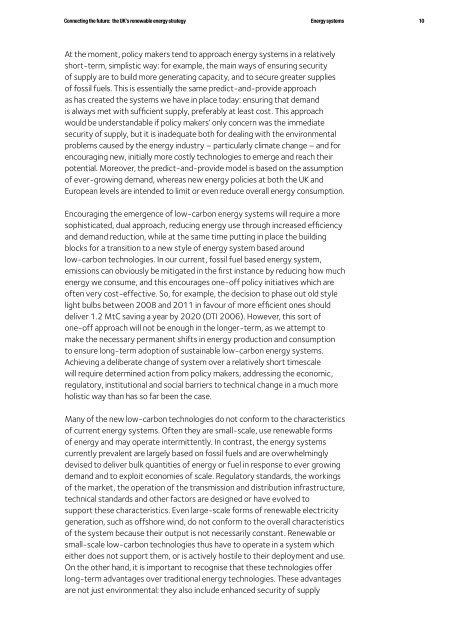Connecting the Future - Greenpeace UK
Connecting the Future - Greenpeace UK
Connecting the Future - Greenpeace UK
You also want an ePaper? Increase the reach of your titles
YUMPU automatically turns print PDFs into web optimized ePapers that Google loves.
<strong>Connecting</strong> <strong>the</strong> future: <strong>the</strong> <strong>UK</strong>’s renewable energy strategy<br />
Energy systems<br />
10<br />
At <strong>the</strong> moment, policy makers tend to approach energy systems in a relatively<br />
short-term, simplistic way: for example, <strong>the</strong> main ways of ensuring security<br />
of supply are to build more generating capacity, and to secure greater supplies<br />
of fossil fuels. This is essentially <strong>the</strong> same predict-and-provide approach<br />
as has created <strong>the</strong> systems we have in place today: ensuring that demand<br />
is always met with sufficient supply, preferably at least cost. This approach<br />
would be understandable if policy makers’ only concern was <strong>the</strong> immediate<br />
security of supply, but it is inadequate both for dealing with <strong>the</strong> environmental<br />
problems caused by <strong>the</strong> energy industry – particularly climate change – and for<br />
encouraging new, initially more costly technologies to emerge and reach <strong>the</strong>ir<br />
potential. Moreover, <strong>the</strong> predict-and-provide model is based on <strong>the</strong> assumption<br />
of ever-growing demand, whereas new energy policies at both <strong>the</strong> <strong>UK</strong> and<br />
European levels are intended to limit or even reduce overall energy consumption.<br />
Encouraging <strong>the</strong> emergence of low-carbon energy systems will require a more<br />
sophisticated, dual approach, reducing energy use through increased efficiency<br />
and demand reduction, while at <strong>the</strong> same time putting in place <strong>the</strong> building<br />
blocks for a transition to a new style of energy system based around<br />
low-carbon technologies. In our current, fossil fuel based energy system,<br />
emissions can obviously be mitigated in <strong>the</strong> first instance by reducing how much<br />
energy we consume, and this encourages one-off policy initiatives which are<br />
often very cost-effective. So, for example, <strong>the</strong> decision to phase out old style<br />
light bulbs between 2008 and 2011 in favour of more efficient ones should<br />
deliver 1.2 MtC saving a year by 2020 (DTI 2006). However, this sort of<br />
one-off approach will not be enough in <strong>the</strong> longer-term, as we attempt to<br />
make <strong>the</strong> necessary permanent shifts in energy production and consumption<br />
to ensure long-term adoption of sustainable low-carbon energy systems.<br />
Achieving a deliberate change of system over a relatively short timescale<br />
will require determined action from policy makers, addressing <strong>the</strong> economic,<br />
regulatory, institutional and social barriers to technical change in a much more<br />
holistic way than has so far been <strong>the</strong> case.<br />
Many of <strong>the</strong> new low-carbon technologies do not conform to <strong>the</strong> characteristics<br />
of current energy systems. Often <strong>the</strong>y are small-scale, use renewable forms<br />
of energy and may operate intermittently. In contrast, <strong>the</strong> energy systems<br />
currently prevalent are largely based on fossil fuels and are overwhelmingly<br />
devised to deliver bulk quantities of energy or fuel in response to ever growing<br />
demand and to exploit economies of scale. Regulatory standards, <strong>the</strong> workings<br />
of <strong>the</strong> market, <strong>the</strong> operation of <strong>the</strong> transmission and distribution infrastructure,<br />
technical standards and o<strong>the</strong>r factors are designed or have evolved to<br />
support <strong>the</strong>se characteristics. Even large-scale forms of renewable electricity<br />
generation, such as offshore wind, do not conform to <strong>the</strong> overall characteristics<br />
of <strong>the</strong> system because <strong>the</strong>ir output is not necessarily constant. Renewable or<br />
small-scale low-carbon technologies thus have to operate in a system which<br />
ei<strong>the</strong>r does not support <strong>the</strong>m, or is actively hostile to <strong>the</strong>ir deployment and use.<br />
On <strong>the</strong> o<strong>the</strong>r hand, it is important to recognise that <strong>the</strong>se technologies offer<br />
long-term advantages over traditional energy technologies. These advantages<br />
are not just environmental: <strong>the</strong>y also include enhanced security of supply




![[2007] EWHC 311 - Greenpeace UK](https://img.yumpu.com/22079793/1/184x260/2007-ewhc-311-greenpeace-uk.jpg?quality=85)











